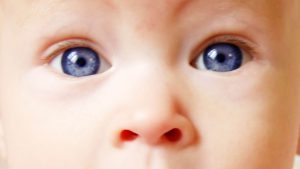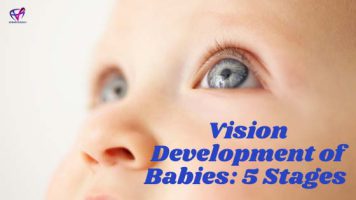Vision Development of Babies: 5 Stages
Vision Development
Your little one has quite recently arrived! A standout amongst the most charming sights that observe you is those minor minimal beady eyes moving and looking around the environment. You ponder what he sees and if babies can see precisely the manner in which grown-ups do. It is a significant interest that most guardians have, and we are out to answer that. While an infant’s eyes are immature, shading vision is available during childbirth. His vision will create through a progression of continuous headways.
Vision Development in Babies: When Can Babies See?

Babies have a grown-up-like flawless shading vision before the finish of the ninth month, and it refines before the finish of the primary year. High differentiation hues will catch his consideration more than anything. Your infant’s eyes are fit for seeing legitimately during childbirth, yet his mind isn’t yet prepared to process and decipher such complex data. Babies can see shading during childbirth yet it is extremely simple, and the capacity to process distinctive shades of shading is constrained.
Your child will see things in full shading vision through the progressive development of the eye. How about we see this well-ordered development of your infant’s vision through the course of the initial year of his life.
Vision Development In Babies
We have isolated the baby’s Vision Development into the accompanying age classifications:
Infant’s Sight During childbirth (Infant): 5 Things To Know
- The crude eye: Your infant’s eyes begin as two little scores on the creation of developing life from day 22 of your pregnancy. This is the antecedent organ for the arrangement of the optic nerve and along these lines the eye.
- A check for innate eye issues: The minute your infant is conceived, the specialist checks for any inborn eye issues, which are surrenders that happen in the belly. The specialist may manage some eye drops to repress the development of any eye disease.
- How babies see: during childbirth, your infant can see protests just in shades of dark, and high contrast. This is on the grounds that the nerve cells in the mind and the eye are yet to grow totally.
- Constrained focal point center: He won’t have the capacity to move his eyes between two target protests and can concentrate on articles that lie between 8-10 crawls from his face.
- Refractive mistakes: Your infant will have characteristic refractive blunders in his eyes. These are mistakes for which grown-ups wear glasses. Be that as it may, in babies, this is no reason for stress since the mistakes occur because of a creating retina, and will decrease as they develop. You will likewise see that he reacts to brilliant light by squinting or shutting them.
Vision Development in Babies

9 Realities About Child’s Sight During 0-2 Months
- What hues do babies see first? Your infant can see all hues during childbirth, yet it isn’t known, which hues he can see clearer than the rest. Studies have demonstrated that babies can separate between essential hues, for example, red, blue, and green. A few babies may likewise indicate inclination or an appreciation for a specific essential shading. In any case, despite everything he cannot separate between comparative-looking hues, for example, red and orange. This implies he can translate a shading yet can’t separate between the different shades (light green and light green).
- May give numb articulations: An allurement towards high differentiation hues implies that he will look straight at you, however, his mind cannot process visual information totally. Along these lines, don’t worry in the event that he gives an empty articulation in the event that you grin or wink at him.
- Expanded students: Your child’s understudies are choked for the initial two weeks to confine the passage of light since the retina is as yet touchy. It is simply after the third week that his understudies start to expand to give all the more light access. Weeks after his introduction to the world, you will see that he opens his eyes for progressively unequivocal time interims.
- Foggy vision: For the first month, your infant’s vision will resemble seeing through a thick mist. Items should be enormous, intense, and brilliant to inspire a reaction from him. His vision will even now be fluffy.
- Vision-hearing coordination creates: Before the finish of the main month, he will have conventional vision-hearing coordination. This implies on the off chance that you play a shake before him (at a separation of 8-10 inches), he will react by taking a gander at it.
- Fringe vision creates: He will have a great fringe vision and will quickly have the capacity to concentrate on an article three feet away.
- Figuring out how to center: Your child’s eyes will seem to meander freely, and he may seem cross-looked. This is typical since he is as yet figuring out how to concentrate on items.
- Shading clearness: Before the second’s over a month, he will have the capacity to perceive between shades of shading. He will demonstrate an inclination toward more brilliant shades of hues. That is the reason child toys are so strikingly vivid.
- Mom is grinning!: He can now translate a grin on a parent’s face. At two months, your baby will react to your grin with a cute grin. This is a marker that your infant’s visual perception can concentrate on explicit articles on the earth.
4 Things To Think About Sight During 2-4 Months
- Enhanced profundity observation: During this period, your infant’s profundity discernment will enhance, which implies he will have the capacity to pass judgment on how far an article is from him. This is additionally because of better by and large coordination between the eyes and mind.
- Following articles: He can now follow moving items better. In the event that something changes position in his field of vision, he will move his eyes to take a gander at it. He will acutely observe any action around him. Move a shake in his field of vision, and he will look along with the moving clatter. This aptitude is known as follows.
- More hues! The quantity of hues in your infant’s vision palette has now expanded.
- I see you there! Before the finish of the fourth month, he builds up a superior perspective of removed articles. Presently when he sits before the window, he sees through the glass sheet as opposed to concentrating on the glass.
3 Notes Immediately During 4-8 Months
- The brilliant world: By the fifth month, your child’s shading vision is hearty.
- Recollects faces: Profundity discernment and article nature make strides. He momentarily perceives recognizable faces and articles lying even six feet away.
- Item changelessness: His vision is presently gradually progressing to that of a grown-up. He sees littler subtleties and comprehends the intelligent perpetual quality of items. This implies on the off chance that you conceal a toy under a sweeping directly before him, he will realize that the toy exists in that spot.
Vision Development in Babies: Child’s Vision During 9 A year: 4 Things To Know
- Presently I see better: This is when your child, at last, sees the way a grown-up sees. There is presently completely created shading vision, and profundity observation is vastly improved.
- Eye shading perpetual quality: Your child’s eye shading is practically near the last shading that his eyes will have for whatever is left of his life.
- Can tell close far items: When he finishes a year in his life, your infant has a grown-up vision – he can separate between close and far, distinguishes hues one from the other, sees an article at a separation, and perceives natural faces and items.
- Eye-muscle coordination: He will have better coordination between his muscles and vision. Since his muscles are as yet creating, he may seem awkward in his development, yet his vision as such would be produced.
An ordinary eye checkup is constantly suggested for the general prosperity of your little one. In any case, there are some warnings that you should be vigilant.
Vision Development in Babies: Indications Of Eye And Vision Issues
Since his eyes are as yet creating, you should dependably keep a watch on any likely abnormalities. On the off chance that your infant demonstrates the accompanying side effects, he could be experiencing difficulty with his eyes:
- Red or swollen eyelids: This could demonstrate a disease or sensitivity.
- Over the top eye turning: The visual or eye muscles are as yet creating. Along these lines, the infant’s eyes may seem to move freely. In any case, on the off chance that the development is consistent and excessively extraordinary, it could show an issue.
- Too touchy to even think about lighting: If your infant closes his eyes whenever he is venturing out in the sun then he may have a weight issue in the eye or an issue with the retinal cells.
- Over-the-top tearing: The tear organs in babies are as yet created. Along these lines, they may experience the ill effects of conditions like over-the-top tearing or blockage.
- The appearance of a white student: This could mean anything from cancer to waterfall, so it is something that requires provoke medicinal consideration.
There are a few conditions that are difficult to decipher, and you might need to counsel a restorative professional.
Vision Development in Babies: When Would it be advisable for me to Take My Child For Eye Checkup?
A customary eye checkup is constantly prescribed for Vision Development in babies. Following are normal eye illnesses found in babies that can be identified through ordinary eye checkups:
- Waterfalls: The eye focal point of babies is clearly similar to that of grown-ups. Yet, in some uncommon cases, the child might be brought into the world with shadiness in his focal point, which is alluded to as a waterfall. A waterfall is generally spotted following the birth or half a month after a restorative checkup by a pediatrician. Waterfalls can be amended with medical procedures very like the one that improved the situation of grown-ups.
- Blocked tear channels: Now and then an infant can be brought into the world with a blocked tear pipe that can cause swelling and redness around the lower or upper eyelid. Babies have an immature resistant framework, and an aroused tear conduit can turn into a rearing ground for microscopic organisms. Provoking anti-toxin intercession can stay away from the danger of the infant losing his vision.
- Amblyopia: This is additionally alluded to as lethargic eye disorder. In this condition, the child loses vision in one eye because of the absence of utilization. The condition is caused because of various reasons from the essential absence of mind eye coordination to a crossed eye. Amblyopia can be hard to identify since both eyes look alive and well and typical. A normal checkup with an ophthalmologist should help in recognizing the condition early.
- Strabismus: In the initial four months, your infant’s eyes seem to move autonomously, without coordination. From the fifth month, the visual muscles create coordination. On the off chance that your child demonstrates incessant eye misalignment even in the 6th month then it could be an indication of strabismus, normally called a crossed eye or squint. Strabismus can be identified amid ordinary eye checkups however in the event that you feel something wrong with his eyes, take him to an eye specialist promptly.
- Retinopathy: Retinopathy is the harm to the retina when the child is conceived rashly. It happens as the veins in the retina are not shaped totally or have anomalous development. Retinopathy in babies can be effortlessly identified by a specialist amid an ophthalmic examination.
- Ptosis: The eyelids are held and set up by muscles. Now and again, an infant might be brought into the world with an immature eyelid muscle that will make the eyelid hang automatically. This condition alludes to Ptosis. Ptosis itself may not be a risk but rather it can prompt Amblyopia, which thusly can cause vision misfortune in the eye with the sagging eyelid. Fortunately, Ptosis can be effortlessly spotted and a remedial medical procedure can fix it.
How To Help Your Infant’s Vision Development?

You may find a way to help your infant’s eye development.
0-2 months:
- Utilize high differentiation design toys and put them around 10 inches from the infant when he is playing.
- Utilize diminished fake lighting in the infant’s room. Sharp lights would irritate him.
- Youthful babies generally see their mom’s face while breastfeeding, so continue substituting the sides while nourishing with the goal that he gets the opportunity to see you from both eyes.
- When he is a month-and-a-half old, play a basic gaze amusement. Hold your child seven inches away and investigate his eyes. When he sees straight in your eyes, move gradually from side to side. He ought to tail you with his look. This makes an incredible eye practice for your infant.
- When he is two months old, he will grin and react to your outward appearances. Make it a point to look straight in his eyes and grin or talk. This will help enhance his concentration and visual consideration.
2-4 months:
- Your infant’s shading vision creates during this period. Acquaint him with brilliant articles and toys that are painted in distinctive hues.
- An infant rec center is an extraordinary place for him to practice his eye control. You can put distinctive sorts of dangling toys and let him look and contact them all while lying on his back.
4-8 months:
- Give him shaded squares to play. Present to him a crate of foods grown from the ground he sees all the lively normal hues.
- Play shrouded objects diversion, and recreations like finding the stowaway. You can likewise play scaled-down fortune chase recreations, which will invigorate him to react to a visual upgrade.
- Toys with brilliant hues and high difference examples will in any case be his top picks. Hence, acquaint him with examples that will lure and hold his visual consideration.
9 a year:
- Incorporate moving article diversions in his playtime. Play straightforward amusements with a toss ball and toys connected to the string.
- Have story time sessions where you open a splendidly shaded and delineated book before him and read through it. Urge him to point toward the illustration, and provoke him to state its name.
- Babies love human countenances, so have as much family holding as you can. It is an extraordinary method to invigorate his capacity to learn and review new faces.
Untimely Infant Vision Development
Untimely babies have fundamentally immature organs, including eyes. This puts them at a higher danger of complexities when it comes to visual development. Untimely or preterm babies have shut eyelids, which open immediately. They cannot see legitimately and have a slower rate of eye development than babies brought into the world after ordinary terms. Through consideration and medicine, their vision development can be lined up with that of ordinary babies.
Untimely babies risk building up a condition called retinopathy of rashness. It prompts harm to the retina that can be perpetual. What raises the hazard in untimely babies, aside from immature eyes, is the overabundance utilization of oxygen because of ineffectively created lungs that are not yet fit for isolating oxygen from the air. An overabundance of oxygen meddles with the development of the veins that supply blood to the retina. This may, really, lead to bringing down oxygen supply to retinal cells causing serious harm. Retinopathy of rashness can be treated amid the general course of consideration and nursing of an untimely infant.
The eyes are an essential yet sensitive piece of your child’s body. You have to deal with them ideal from his infanthood, in order to maintain a strategic distance from any issues later on. Monitor the development of his eyes, and in the event that you discover any abnormalities, take him to a specialist promptly. The prior you react, the better it is for your infant.
Also Read:
